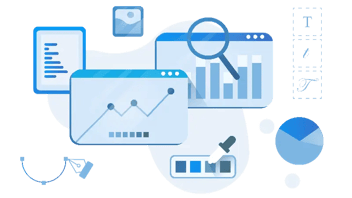Design orientato alla crescita: cosa fare dopo il lancio del sito?
Lanciare un sito web con un layout tradizionale sta rapidamente diventando un metodo obsoleto per coltivare una presenza online. Il GDD, o growth-driven design, è sempre più popolare grazie alla sua capacità di focalizzarsi su obiettivi e target specifici senza spendere eccessivamente in budget di marketing. Dopo aver lanciato il vostro sito web GDD, vi chiederete cosa succederà dopo. Fortunatamente per gli imprenditori, l'utilizzo del growth-driven design spesso indica che il lavoro è raramente finito, poiché le aziende e i consumatori sono in continua evoluzione.

Che cos'è il GDD (Growth-Driven Design)?
Il GDD, o growth-driven design, è il processo di progettazione di un sito web o di una presenza online in base a obiettivi specifici e a un pubblico target, che possono cambiare o modificarsi in base ai dati in entrata ricevuti in tempo reale. Con il GDD si evita di annoiare i visitatori con una pagina web statica e obsoleta. Utilizzate invece i dati che vi interessano per creare un layout e una presenza online che risuoni veramente con il pubblico che volete raggiungere.
Il processo GDD
La metodologia di progettazione orientata alla crescita sarà probabilmente unica per la vostra azienda, il pubblico che intendete raggiungere e gli obiettivi particolari che avete in mente. Il processo GDD comprende le seguenti fasi, che possono essere approfondite in base alle esigenze individuali del vostro sito web:
-
Strategia: Quali sono gli obiettivi del vostro sito web? Chi state cercando di raggiungere in termini di pubblico con la vostra presenza online? Chi è il vostro cliente ideale e come intendete utilizzare il vostro sito web per attirarlo? Su quali punti dolenti vi concentrate per attirare gli utenti sul vostro sito web o sulla vostra presenza online?
-
Personas: Vi rivolgete a un gruppo specifico di individui o a una persona che ha maggiori probabilità di trovare il vostro sito utile, interessante o necessario? A quale fascia d'età e a quali dati demografici si rivolge il vostro progetto di design orientato alla crescita?
-
Analisi e dati in tempo reale: Il GDD, o growth-driven design, non funziona senza aggiornamenti continui e analisi in tempo reale. I dati e le analisi in tempo reale forniscono indicazioni preziose su ciò che funziona nel vostro sito web e su ciò che potrebbe richiedere modifiche o aggiornamenti. L'uso di dati in tempo reale può anche aiutarvi a capire meglio i desideri, le esigenze e le spinte degli utenti del vostro sito web.
-
Ricerca sugli utenti: Nel corso del tempo, qualsiasi azienda ha bisogno di capire il pubblico che sta raggiungendo, anche se sta raggiungendo una base di utenti che in origine era imprevedibile. Anche il contatto con gli utenti o i clienti esistenti per conoscere le loro opinioni sul layout e sulle funzionalità del vostro sito web può essere utile quando si sviluppa con GDD.
GDD: passo dopo passo
Una volta deciso che il GDD, o growth-driven design, fa al caso vostro, la collaborazione con un team di designer e sviluppatori può aiutarvi a semplificare il processo. In genere, la progettazione di un sito web con un design orientato alla crescita richiede le seguenti fasi:
-
Esame della lista dei desideri del cliente: Prima di creare un sito web di prova o un sito di lancio, è indispensabile rivedere la lista dei desideri del cliente in termini di pubblico previsto, caratteristiche specifiche a cui è interessato e persino elementi di design fondamentali per il sito web e la presenza online che desidera costruire.
-
Creazione di un sito web di lancio: Lo sviluppo di un sito web di lancio è un'altra fase importante della collaborazione con GDD. Un sito web di lancio è essenzialmente una dimostrazione dal vivo del sito web che si sta progettando e costruendo. Un sito web di lancio può essere utile quando si lavora direttamente con gli sviluppatori e i designer di GDD, in quanto non sarà disponibile al pubblico, ma funzionerà come il vostro sito web ufficiale una volta che sarà in vita.
-
Analisi della lista dei desideri: Una volta che avete un sito web di base con cui lavorare, potete iniziare a esaminare la vostra lista dei desideri per configurare le caratteristiche e le funzionalità che vi interessano di più e a cui dare priorità.
-
Miglioramento continuo: con GDD, potete aspettarvi miglioramenti continui e costanti, in quanto il vostro team di sviluppo e progettazione di GDD sfrutta le migliori caratteristiche e gli elementi di design del vostro sito web originale.
-
Ricerca aggiuntiva: La ricerca e la raccolta di dati aggiuntivi è utile anche per i team di sviluppo GDD, anche quando si lavora con un sito web di lancio. Più dati sono disponibili per una particolare base di utenti, più facile diventa individuare le funzioni. È più probabile che le sue caratteristiche li interessino una volta che il sito web sarà disponibile al pubblico online.
GDD dopo il lancio: Cosa succede dopo?
Dopo aver deciso di adottare la GDD per il vostro sito web e averne progettato il layout, vi starete chiedendo cosa succederà dopo. Poiché il GDD è molto diverso dal design tradizionale, potete aspettarvi continui aggiornamenti e modifiche al vostro sito web, a seconda dei servizi che avete scelto di offrire ai vostri fornitori di GDD. Dopo il lancio iniziale del GDD, potete aspettarvi quanto segue:
-
Revisione delle prestazioni rispetto agli obiettivi: La verifica delle prestazioni complessive del vostro sito web rispetto agli obiettivi che avete fissato prima del lancio è una priorità assoluta per gli sviluppatori GDD. Anche se i risultati varieranno in base ai vostri obiettivi specifici, rimanere aggiornati sulle prestazioni del vostro sito GDD e sugli obiettivi originali che avete stabilito è un fattore essenziale per una progettazione orientata alla crescita. Anche la costante rielaborazione degli obiettivi che si intende raggiungere non è rara e può essere incorporata nel processo di progettazione orientata alla crescita.
-
Ulteriori ricerche: Il processo di progettazione orientato alla crescita è continuo e in continua evoluzione, il che significa che potreste aver bisogno di ricercare e conoscere meglio i desideri e le esigenze del vostro pubblico, soprattutto se lavorate in un mercato altamente competitivo e saturo. La ricerca continua può aiutare a chiarire quali cambiamenti devono essere implementati nel design del sito per aumentare i tassi di conversione e ridurre la frequenza di rimbalzo. Utilizzate i dati in tempo reale per evitare di apportare modifiche inutili o indesiderate al vostro sito web e alla vostra presenza online.
-
Dati di marketing e di vendita: L'utilizzo dei dati di marketing e di vendita può anche fornire preziose indicazioni sull'efficacia complessiva del design del vostro sito web orientato alla crescita. Utilizzate i dati di marketing e di vendita per implementare nuovi elementi di azione nei piani di progettazione futuri che state pensando per la vostra presenza online. I dati di marketing e di vendita in tempo reale possono anche aiutarvi a capire quali prodotti o servizi del vostro settore sono attualmente richiesti e quali prodotti sono al di sotto delle aspettative.
Comprendere il growth-driven design e il modo in cui può portare benefici significativi a qualsiasi azienda online oggi è essenziale, sia che si tratti di un'azienda locale sia che si tratti del lancio di un marchio internazionale online. Con il GDD, ottimizzate la capacità di attrarre il vostro pubblico di riferimento, massimizzando la vostra portata online.
Non sapete da dove cominciare con il growth-driven design? Date un'occhiata al nostro classificatore di siti web gratuito per avere qualche idea.
Questo contenuto è disponibile in:
- Tedesco: Wachstumsorientiertes Design: Was passiert nach dem Start der Website?
- Inglese: Growth-Driven Design: What Happens After The Website Launch?
- Spagnolo: Growth-Driven Design: Optimización continua tras el lanzamiento
- Francese: Growth-Driven Design post-lancement d'un site web : quelles étapes?
- Rumeno: Design orientat spre creștere: Ce se întâmplă după lansarea site-ului?
- Cinese: 增长驱动型设计:网站发布后会发生什么?









Facci sapere cosa ne pensi.